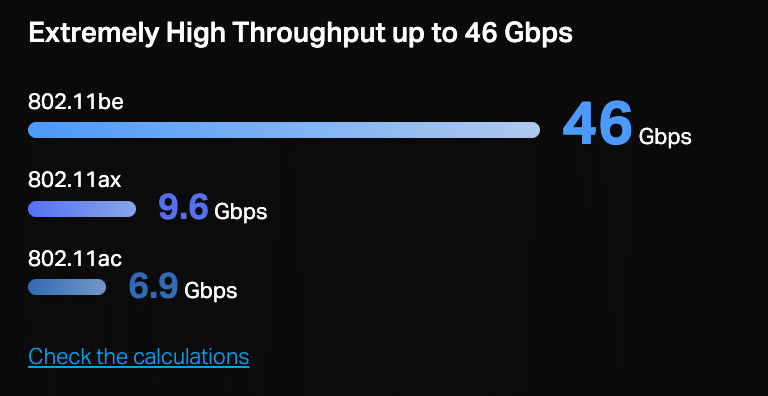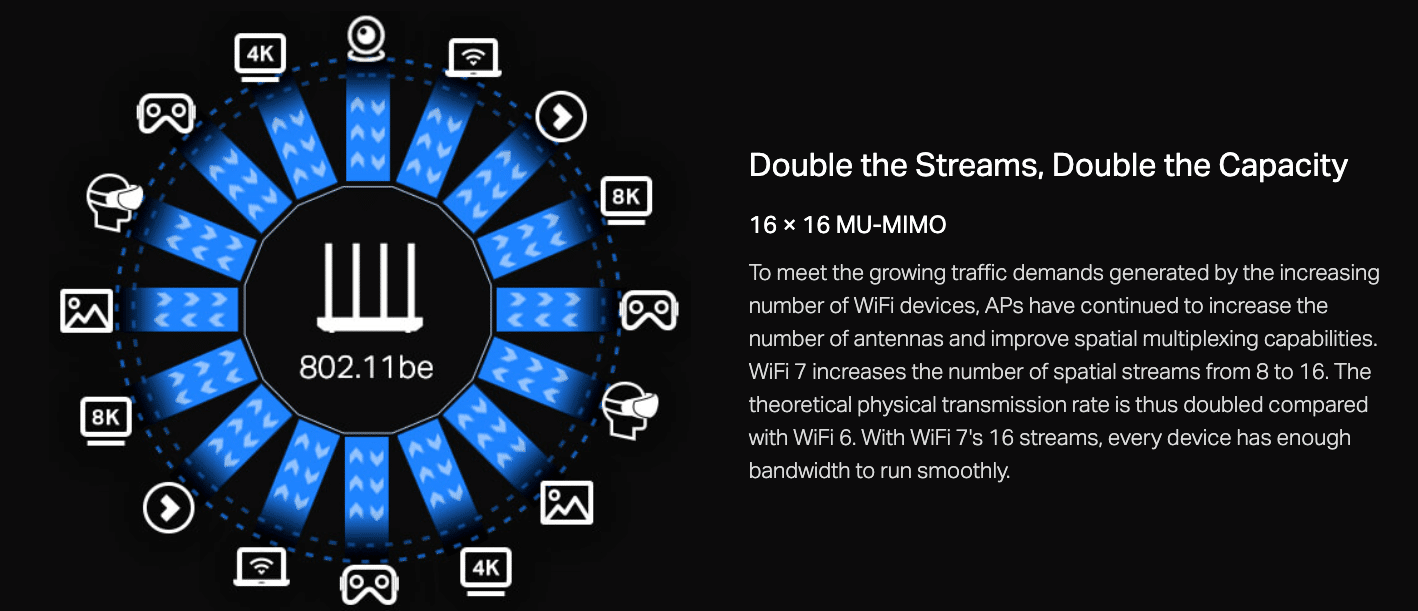Even while some technological advancements may appear to have stalled recently, wireless communication has continued to advance at an exponential rate.
With transfer speeds that could render Ethernet cables obsolete, Wi-Fi 7 has here. Let’s examine the promises made in the proposed specification.
What Is Wi-Fi 7? How Fast Is It?
Wi-Fi 7, officially released in January 2024, represents the latest evolution of Wi-Fi technology, building upon the solid foundation laid by Wi-Fi 6E. This leap forward is centered around the 802.11be standard, which first saw the light of day in May 2021.
Perhaps the most revolutionary aspect of Wi-Fi 7 is its potential to make traditional wired connections, like Ethernet, a thing of the past for many users. In its first public demonstration early in 2022, Wi-Fi 7 flaunted astonishing capabilities.
Theoretically, it boasts bandwidth capacities reaching up to 46 gigabits per second (Gbps) for each access point. This speed is nearly fivefold the peak 9.6 Gbps offered by its predecessor, Wi-Fi 6, making Wi-Fi 7 a beacon of “Extremely High Throughput,” or EHT.

Meanwhile, the quickest wired Ethernet connections available to consumers today tap out at 10 Gbps, with more formidable speeds relegated to specialized environments such as data centers.
Thus, Wi-Fi 7 emerges as a viable wireless alternative for users currently reliant on Gigabit and 10 Gigabit Ethernet, promising enhanced flexibility without sacrificing performance. This is not to say that wired connections will vanish overnight.
For those requiring maximum stability and security, such as electrical and electronics engineers, a physical connection may remain the gold standard for some time.
Nonetheless, Wi-Fi 7 marks a significant milestone in wireless connectivity, driving forward multi-gigabit speeds, lower latency, and the promise of a seamlessly connected future for both homes and businesses.
There are many Wifi devices available for Wifi 7 like TP-Link and many others, But it’s not as pocket friendly yet!
What Else Is Cool About Wi-Fi 7?

In addition to Wi-Fi 7’s theoretically possible lightning-fast speeds, the Wi-Fi Alliance intends to add additional noteworthy enhancements to the Wi-Fi standard. here are the key features of Wi-Fi 7:
Full Utilization of the 6 GHz Band

The adoption of the new 6 GHz band, spanning 5.925–7.125 GHz, initially supported by Wi-Fi 6E, is fully leveraged in Wi-Fi 7. This band is presently dedicated solely to Wi-Fi technologies, although future changes could occur.
Utilizing the 6 GHz spectrum significantly reduces interference compared to the more crowded 2.4 GHz or 5 GHz bands, enhancing Wi-Fi 7’s appeal. This advancement in spectrum utilization not only exemplifies Wi-Fi 7’s commitment to providing ultra-high speeds and lower latency but also illustrates a significant improvement in wireless connectivity.
By tapping into this cleaner band, Wi-Fi 7 services can offer more stable and reliable connections, crucial for supporting the demands of smart homes, cloud gaming, and industrial IoT technologies.

Furthermore, this dedication to optimizing available spectrum resources underscores the Wi-Fi Alliance’s ongoing efforts to refine Wi-Fi technology, ensuring Wi-Fi 7 devices can achieve greater efficiency, increased speed, and reduced latency, which are key benefits for users seeking the best solution for fast, reliable internet access without the constraints of wired connections.
Even Lower Latency
Wi-Fi 7 is designed with the ambition of achieving “lower latency and heightened reliability” which is paramount for Time-Sensitive Networking (TSN), a core component critical for both cloud computing and cloud gaming experiences.
This is in addition to Wi-Fi 7’s intent to act as a robust alternative to traditional wired Ethernet connections. While the advancement from Wi-Fi 5 to Wi-Fi 6 presented notable enhancements in reducing latency, Wi-Fi 7 sets its sights even higher.

Its target is to deliver consistently low latency, aiming for the realm of single-digit milliseconds across the board, for every device connected to the network, without limiting this performance boost to only those devices within ideal coverage zones.
This effort towards minimized latency and increased reliability underpins Wi-Fi 7’s capacity for supporting next-generation applications requiring real-time response and high-speed internet connectivity.
Load Balancing with Multi-Link Operation
Wi-Fi 7 introduces the innovation of Multi-Link Operation (MLO), an advanced feature designed to optimize wireless connectivity by intelligently managing multiple channels across different frequencies.

This innovative approach allows Wi-Fi 7 devices to dynamically switch between various bands and channels, employing the full spectrum of available frequencies to enhance connection speeds while simultaneously avoiding congested frequencies prone to interference.
Significantly, this flexibility in channel utilization underpins Wi-Fi 7’s capacity for achieving theoretical maximum throughputs that are up to three times higher than those offered by the previous generation, Wi-Fi 6. This groundbreaking advancement enhances the Wi-Fi technology landscape by promoting more efficient spectrum resource scheduling, resulting in faster speeds, higher throughput, and a more reliable wireless transmission experience.
Through features like MLO, Wi-Fi 7 not only exhibits compatibility with the existing infrastructure but also sets a new standard for multi-gigabit speeds, lower latency, and the seamless operation of dense Wi-Fi environments, making it a pivotal development for next-generation applications that demand ultra-high-speed internet connectivity.
Upgrades to 802.11ax
Building upon the advancements of previous Wi-Fi generations, Wi-Fi 7 incorporates significant enhancements directly evolving from Wi-Fi 6 technology. One of the notable upgrades includes the expansion of channel width to 320 MHz, doubling the maximum of 160 MHz found in Wi-Fi 6, to facilitate ultra high speeds and more efficient spectrum efficiency.
Additionally, Wi-Fi 7 introduces the adoption of 4096 QAM (Quadrature Amplitude Modulation), a cutting-edge technology that enables a notably higher data rate by packing more data into each transmission, effectively maximizing the data throughput across the network.
These enhancements not only contribute to Wi-Fi 7’s Extremely High Throughput (EHT) capabilities but also underscore its role in setting new benchmarks for wireless transmission, ensuring devices can enjoy faster speeds, higher throughput, and reduced latency.
By integrating these advanced features, Wi-Fi 7 is poised to deliver superior wireless connectivity, accommodating the demanding needs of dense environments, smart home applications, and next-generation technologies like cloud gaming, mesh systems and industrial IoT, all while maintaining backward compatibility with legacy wi fi devices.
FAQs
Is It Backwards Compatible?
Yes, Wi-Fi 7 is designed to be backwards compatible, ensuring seamless integration with devices operating on the 2.4 GHz, 5 GHz, and 6 GHz bands. This backward compatibility means that existing devices, irrespective of their Wi-Fi generation, can connect to Wi-Fi 7-enabled routers without the need for new hardware.
It continues the legacy of cross-generation connectivity, similar to how Wi-Fi 5 devices can connect to Wi-Fi 6 networks, and vice versa.
However, to fully benefit from the cutting-edge features of Wi-Fi 7, including its multi-gigabit speeds, lower latency, and advances in spectrum resource scheduling, utilizing Wi-Fi 7-compatible devices with a Wi-Fi 7 router is advisable.
This ensures the most efficient use of the Wi-Fi technology, offering higher speeds, greater efficiency, and a more reliable wireless connectivity experience across your entire home or office.
Is It Significantly Better Than Wi-Fi 6 and 6E?
In theoretical assessments and controlled testing environments using compatible equipment, Wi-Fi 7 far exceeds the capabilities of its predecessors. Despite this, the full potential of Wi-Fi 7 can only be harnessed when utilized in conjunction with Wi-Fi 7-specific hardware.
Nevertheless, the enhancements brought about by Wi-Fi 6, as previously discussed, will enable Wi-Fi 7 routers to significantly improve the network experience for devices that are still on Wi-Fi 6, ensuring an upgrade in performance and connectivity.
These advancements in Wi-Fi technology, particularly in spectrum resource scheduling, flexible channel utilization, ultra high speeds, and lower latency, underscore Wi-Fi 7’s role in providing next-generation wireless connectivity.
By supporting extremely high throughput and multi-gigabit speeds alongside backward compatibility, Wi-Fi 7 stands as a key innovation in Wi-Fi technology, promising enhanced efficiency, higher throughput, and a more reliable experience in smart home, cloud gaming, and dense environment applications, all while seamlessly integrating with legacy and newer Wi-Fi devices.
Is Wi-Fi 7 More Secure?
Navigating through the myriad of specifications and options available across Wi-Fi generations and router models can indeed be perplexing, especially when considering security standards.
It’s crucial to distinguish between the Wi-Fi standards themselves and the security protocols—specifically, Wireless Protected Access (WPA)—that safe access points. While Wi-Fi 5 embraced the WPA2 security standard, the advent of Wi-Fi 6 and Wi-Fi 6E introduced support for the more robust WPA3 security protocol.
Wi-Fi 7, maintaining this trajectory of security enhancement, comes equipped with WPA3 support, ensuring it offers the highest level of Wi-Fi security currently available. Although discussions around a potential WPA4 standard surface occasionally in technical discourse, it remains a speculative future development.
Consequently, adopting a Wi-Fi 7 router not only equips users with the latest in wireless connectivity, ultra-high speeds, and advanced features like Multi-Link Operation (MLO) and increased spectrum efficiency, but it also guarantees an upgraded security posture compared with previous generations of routers.
This move to Wi-Fi 7 ensures devices enjoy greater efficiency, faster speeds, higher throughput, and the peace of mind that comes with top-tier security in any Wi-Fi technology deployment, whether in densely populated smart homes, cloud gaming, or the industrial IoT sphere.
10 Best RAM Test Software Programs for Windows and Mac
How to test your Computer’s RAM for problems (100% Working)
The Bottom Line: Do I Need a Wi-Fi 7 Router?
Upgrading to a Wi-Fi 7 router might be a smart move, particularly if your current setup is aging and not keeping up with the increasing digital demands of your household.
On the flip side, if you’ve recently invested in a Wi-Fi 6 or Wi-Fi 6E router, there’s less urgency. The leap to Wi-Fi 7 certainly offers advantages, including multi-link operation (MLO), high throughput, and lower latency, but the true value of these features will unfold gradually for those already equipped with Wi-Fi 6 or superior technology.
The pursuit of top performance is enticing, yet for everyday tasks like streaming videos or video conferencing, the bandwidth of current premium systems suffices. Therefore, if your router is an older model purchased years ago, an upgrade could significantly enhance your wireless connectivity experience, exploiting advancements in spectrum efficiency and flexible channel utilization.
However, for those with recent, high-end models, delaying the switch to Wi-Fi 7 could be beneficial until the cost becomes more accessible and wider support amongst devices emerges, leveraging the full potential of Wi-Fi 7’s key benefits in your entire home or office, particularly in dense environments and for applications like cloud gaming and smart home technologies.
Test your knowledge
Take a quick 5-question quiz based on this page.









